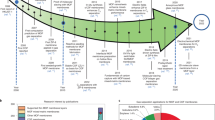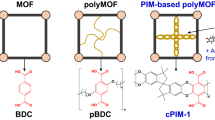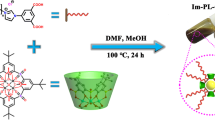Abstract
The combination of well-defined molecular cavities and chemical functionality makes crystalline porous solids attractive for a great number of technological applications, from catalysis to gas separation. However, in contrast to other widely applied synthetic solids such as polymers, the lack of processability of crystalline extended solids hampers their application. In this work, we demonstrate that metal–organic frameworks, a type of highly crystalline porous solid, can be made solution processable via outer surface functionalization using N-heterocyclic carbene ligands. Selective outer surface functionalization of relatively large nanoparticles (250 nm) of the well-known zeolitic imidazolate framework ZIF-67 allows for the stabilization of processable dispersions exhibiting permanent porosity. The resulting type III porous liquids can either be directly deployed as liquid adsorbents or be co-processed with state-of-the-art polymers to yield highly loaded mixed matrix membranes with excellent mechanical properties and an outstanding performance in the challenging separation of propylene from propane. We anticipate that this approach can be extended to other metal–organic frameworks and other applications.
This is a preview of subscription content, access via your institution
Access options
Access Nature and 54 other Nature Portfolio journals
Get Nature+, our best-value online-access subscription
$29.99 / 30 days
cancel any time
Subscribe to this journal
Receive 12 print issues and online access
$259.00 per year
only $21.58 per issue
Buy this article
- Purchase on Springer Link
- Instant access to full article PDF
Prices may be subject to local taxes which are calculated during checkout





Similar content being viewed by others
Data availability
All data generated and/or analysed in this study are included in this published article and its supplementary information file and are also available from the corresponding author (Jorge Gascon) on reasonable request.
References
Bavykina, A. & Gascon, J. An efficient nanosieve. Nat. Mater. 17, 1057–1058 (2018).
Rogge, S. M. J. et al. Metal–organic and covalent organic frameworks as single-site catalysts. Chem. Soc. Rev. 46, 3134–3184 (2017).
Baker, R. W. & Low, B. T. Gas separation membrane materials: a perspective. Macromolecules 47, 6999–7013 (2014).
Dechnik, J., Gascon, J., Doonan, C. J., Janiak, C. & Sumby, C. J. Mixed-matrix membranes. Angew. Chem. Int. Ed. 56, 9292–9310 (2017).
Chung, T.-S., Jiang, L. Y., Li, Y. & Kulprathipanja, S. Mixed matrix membranes (MMMs) comprising organic polymers with dispersed inorganic fillers for gas separation. Prog. Polym. Sci. 32, 483–507 (2007).
Seoane, B. et al. Metal–organic framework based mixed matrix membranes: a solution for highly efficient CO2 capture? Chem. Soc. Rev. 44, 2421–2454 (2015).
Adams, R., Carson, C., Ward, J., Tannenbaum, R. & Koros, W. Metal organic framework mixed matrix membranes for gas separations. Microporous Mesoporous Mater. 131, 13–20 (2010).
Bavykina, A., Cadiau, A. & Gascon, J. Porous liquids based on porous cages, metal organic frameworks and metal organic polyhedra. Coord. Chem. Rev. 386, 85–95 (2019).
Shan, W. et al. New class of type III porous liquids: a promising platform for rational adjustment of gas sorption behavior. ACS Appl. Mater. Interfaces 10, 32–36 (2018).
Costa Gomes, M., Pison, L., Červinka, C. & Padua, A. Porous ionic liquids or liquid metal–organic frameworks? Angew. Chem. Int. Ed. 57, 11909–11912 (2018).
Devaux, A. et al. Solubilisation of dye-loaded zeolite L nanocrystals. Microporous Mesoporous Mater. 90, 69–72 (2006).
Crudden, C. M. et al. Ultra stable self-assembled monolayers of N-heterocyclic carbenes on gold. Nat. Chem. 6, 409–414 (2014).
Man, R. W. Y. et al. Ultrastable gold nanoparticles modified by bidentate N-heterocyclic carbene ligands. J. Am. Chem. Soc. 140, 1576–1579 (2018).
Hopkinson, M. N., Richter, C., Schedler, M. & Glorius, F. An overview of N-heterocyclic carbenes. Nature 510, 485–496 (2014).
NIST Standard Reference Database Number 20 (National Institute of Standards and Technology, 2000).
Li, X., Gao, X., Ai, L. & Jiang, J. Mechanistic insight into the interaction and adsorption of Cr(VI) with zeolitic imidazolate framework-67 microcrystals from aqueous solution. Chem. Eng. J. 274, 238–246 (2015).
Du, X.-D. et al. Extensive and selective adsorption of ZIF-67 towards organic dyes: performance and mechanism. J. Colloid Interface Sci. 506, 437–441 (2017).
Lin, K.-Y. A. & Chang, H.-A. Ultra-high adsorption capacity of zeolitic imidazole framework-67 (ZIF-67) for removal of malachite green from water. Chemosphere 139, 624–631 (2015).
Gross, A. F., Sherman, E. & Vajo, J. J. Aqueous room temperature synthesis of cobalt and zinc sodalite zeolitic imidizolate frameworks. Dalton Trans. 41, 5458–5460 (2012).
Zhu, Y. et al. Unravelling surface and interfacial structures of a metal–organic framework by transmission electron microscopy. Nat. Mater. 16, 532–536 (2017).
Xia, W. et al. Well-defined carbon polyhedrons prepared from nano metal–organic frameworks for oxygen reduction. J. Mater. Chem. A 2, 11606–11613 (2014).
Falivene, L., Kozlov, S. M. & Cavallo, L. Constructing bridges between computational tools in heterogeneous and homogeneous catalysis. ACS Catal. 8, 5637–5656 (2018).
O’Reilly, N., Giri, N. & James, S. L. Porous liquids. Chem. Eur. J. 13, 3020–3025 (2007).
James, S. L. The dam bursts for porous liquids. Adv. Mater. 28, 5712–5716 (2016).
Gaillac, R. et al. Liquid metal–organic frameworks. Nat. Mater. 16, 1149–1154 (2017).
Melaugh, G., Giri, N., Davidson, C. E., James, S. L. & Del Pópolo, M. G. Designing and understanding permanent microporosity in liquids. Phys. Chem. Chem. Phys. 16, 9422–9431 (2014).
Zhang, J. et al. Porous liquids: a promising class of media for gas separation. Angew. Chem. Int. Ed. 54, 932–936 (2015).
Ma, L. et al. Coordination cages as permanently porous ionic liquids. Nat. Chem. 12, 270–275 (2020).
Giri, N. et al. Liquids with permanent porosity. Nature 527, 216–220 (2015).
Hasell, T. et al. Controlling the crystallization of porous organic cages: molecular analogs of isoreticular frameworks using shape-specific directing solvents. J. Am. Chem. Soc. 136, 1438–1448 (2014).
Liu, S. et al. Porous liquid: a stable ZIF-8 colloid in ionic liquid with permanent porosity. Langmuir 34, 3654–3660 (2018).
Sochi, T. Non-Newtonian flow in porous media. Polymer 51, 5007–5023 (2010).
Dechnik, J., Sumby, C. J. & Janiak, C. Enhancing mixed-matrix membrane performance with metal–organic framework additives. Cryst. Growth Des. 17, 4467–4488 (2017).
Krokidas, P. et al. ZIF-67 framework: a promising new candidate for propylene/propane separation. Experimental data and molecular simulations. J. Phys. Chem. C. 120, 8116–8124 (2016).
Zhang, C., Dai, Y., Johnson, J. R., Karvan, O. & Koros, W. J. High performance ZIF-8/6FDA-DAM mixed matrix membrane for propylene/propane separations. J. Membr. Sci. 389, 34–42 (2012).
An, H., Park, S., Kwon, H. T., Jeong, H.-K. & Lee, J. S. A new superior competitor for exceptional propylene/propane separations: ZIF-67 containing mixed matrix membranes. J. Membr. Sci. 526, 367–376 (2017).
Liu, Y. et al. Conformation-controlled molecular sieving effects for membrane-based propylene/propane separation. Adv. Mater. 31, 1807513 (2019).
Liu, G. et al. Enabling fluorinated MOF-based membranes for simultaneous removal of H2S and CO2 from natural gas. Angew. Chem. Int. Ed. 57, 14811–14816 (2018).
Liu, D. et al. Rational matching between MOFs and polymers in mixed matrix membranes for propylene/propane separation. Chem. Eng. Sci. 204, 151–160 (2019).
Yu, J., Wang, C., Xiang, L., Xu, Y. & Pan, Y. Enhanced C3H6/C3H8 separation performance in poly(vinyl acetate) membrane blended with ZIF-8 nanocrystals. Chem. Eng. Sci. 179, 1–12 (2018).
Lin, R., Ge, L., Diao, H., Rudolph, V. & Zhu, Z. Propylene/propane selective mixed matrix membranes with grape-branched MOF/CNT filler. J. Mater. Chem. A 4, 6084–6090 (2016).
Askari, M. & Chung, T.-S. Natural gas purification and olefin/paraffin separation using thermal cross-linkable co-polyimide/ZIF-8 mixed matrix membranes. J. Membr. Sci. 444, 173–183 (2013).
Kwon, H. T., Jeong, H.-K., Lee, A. S., An, H. S. & Lee, J. S. Heteroepitaxially grown zeolitic imidazolate framework membranes with unprecedented propylene/propane separation performances. J. Am. Chem. Soc. 137, 12304–12311 (2015).
Zhou, S. et al. Paralyzed membrane: current-driven synthesis of a metal–organic framework with sharpened propene/propane separation. Sci. Adv. 4, eaau1393 (2018).
Wijmans, J. G. & Baker, R. W. The solution–diffusion model: a review. J. Membr. Sci. 107, 1–21 (1995).
Cooper, A. I. Porous molecular solids and liquids. ACS Cent. Sci. 3, 544–553 (2017).
Kraftschik, B., Koros, W. J., Johnson, J. R. & Karvan, O. Dense film polyimide membranes for aggressive sour gas feed separations. J. Memb. Sci. 428, 608–619 (2013).
Acknowledgements
L.S., A.K. and J.C. acknowledge support by the Deutsche Forschungsgemeinschaft in the priority program SPP 1928 COORNETs (Coordination Networks: Building Block for Functional Systems), grant no. CA 147/20-1 (J.C.). R.A., S.K and L.C. acknowledge the Supercomputing Laboratory at KAUST for computational resources (Cray XC40, ShaheenII). We thank P. M. Bhatt for helping with the propylene/propane adsorption kinetic study. King Abdullah University of Science and Technology is acknowledged for financial support.
Author information
Authors and Affiliations
Contributions
J.G. and A.K. conceived and designed the project and managed cooperation between KAUST, LUH and DIK. A.K., L.S., L.G.-T. and A.B. were responsible for the synthesis and functionalization of the particles. A.K. and L.S. performed the X-ray dispersion, SEM and ATR-FTIR measurements. A.B. and S.J.D. were responsible for the adsorption measurements. A.B., L.G.-T. and S.D. performed the breakthrough measurements. D.S. and I.W. performed and helped with interpretation of the dynamic viscosity measurements. G.S. performed the X-ray photoelectron spectroscopy measurements. L.G.-T. performed NMR measurements. Y.L. proposed the use of and synthesized the carbenes. S.D. obtained adsorption isotherms on the liquid samples. S.J.D. and M.E. designed MMMs. S.J.D. fabricated and analysed MMMs and measured propylene and propane sorption isotherms on MOFs powder, MMMs and polymers. S.J.D. calculated solubility and diffusivity and described the MMM findings in the manuscript. M.K. performed membrane permeation tests. I.D.C. synthesized 6FDA-DHTM-Durene polymer. I.D.C. and S.J.D. characterized MMMs using SEM, X-ray diffraction, thermal gravimetric analysis and ATR-FTIR. R.A., S.K. and L.C. performed density functional theory simulations. A.K., L.S., A.B., J.C., S.J.D., R.A., S.K., L.C. and J.G. drafted the paper. All authors contributed to the writing of the manuscript.
Corresponding authors
Ethics declarations
Competing interests
The authors declare no competing interests.
Additional information
Publisher’s note Springer Nature remains neutral with regard to jurisdictional claims in published maps and institutional affiliations.
Supplementary information
Supplementary Information
Supplementary discussion, Figs. 1–54 and Tables 1–14.
Supplementary Video 1
Focused ion beam SEM reconstruction of a ZIF-67-IDip/6FDA-DAM MMM.
Rights and permissions
About this article
Cite this article
Knebel, A., Bavykina, A., Datta, S.J. et al. Solution processable metal–organic frameworks for mixed matrix membranes using porous liquids. Nat. Mater. 19, 1346–1353 (2020). https://doi.org/10.1038/s41563-020-0764-y
Received:
Accepted:
Published:
Issue Date:
DOI: https://doi.org/10.1038/s41563-020-0764-y
This article is cited by
-
Precise control over gas-transporting channels in zeolitic imidazolate framework glasses
Nature Materials (2024)
-
Roll-to-roll fabrication of large-area metal–organic framework-based membranes for high-performance aqueous separations
Nature Water (2024)
-
Crosslinking-induced patterning of MOFs by direct photo- and electron-beam lithography
Nature Communications (2024)
-
Breathing porous liquids based on responsive metal-organic framework particles
Nature Communications (2023)
-
Hydrogen-bonding and π-π interaction promoted solution-processable covalent organic frameworks
Nature Communications (2023)



